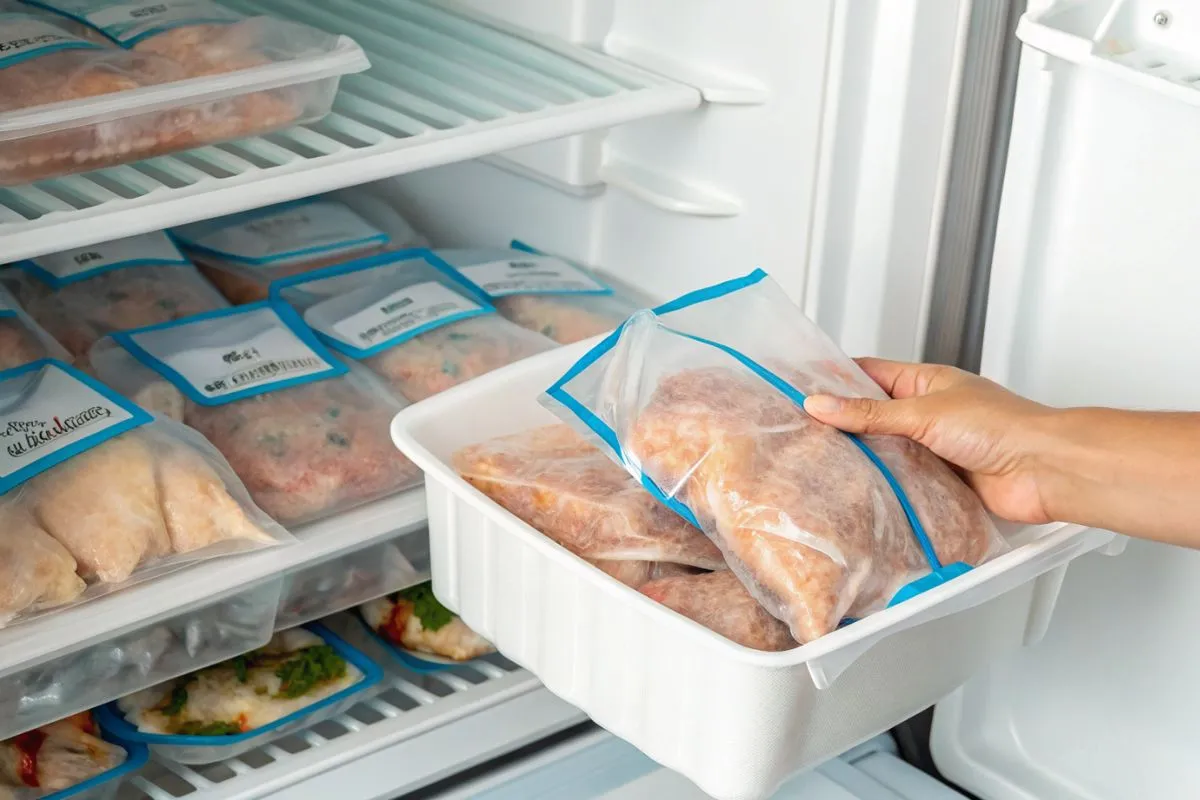Rotisserie chicken is a convenient, delicious option for busy weeknights or quick meals. Whether you’ve picked one up from the grocery store or made it yourself, proper storage is key to keeping it fresh and safe to eat. But how do you know when it’s time to toss it? This comprehensive guide will walk you through everything you need to know about storing rotisserie chicken, including timelines, tips, and safety practices.
From refrigeration to freezing, we’ll cover all the bases so you can enjoy your chicken without worry. Let’s dive into the details of how to maximize its shelf life while maintaining flavor and quality.
How Long Does Rotisserie Chicken Last in the Fridge?

When you bring home a rotisserie chicken, the clock starts ticking. The amount of time it stays fresh depends on how you store it. In the refrigerator, a rotisserie chicken typically remains safe to eat for a limited window. Knowing this timeline can help you avoid food waste and potential health risks.
The general rule of thumb is straightforward, but there are a few factors—like temperature and packaging—that can affect the outcome. Let’s break it down so you can plan your meals with confidence.
How Long Does Rotisserie Chicken Last in the Fridge When Stored Properly?
Proper storage is the secret to extending the life of your rotisserie chicken. According to the U.S. Department of Agriculture (USDA), cooked chicken, including rotisserie varieties, can be kept in the fridge at or below 40°F (4°C) for up to 3 to 4 days. Beyond that, the risk of bacterial growth increases, which could lead to foodborne illness.
To hit that 3-to-4-day mark, you’ll need to store it correctly. Leaving it in its original packaging is fine for a day or two, but for maximum freshness, transfer it to an airtight container or wrap it tightly in aluminum foil or plastic wrap. This prevents air exposure, which can speed up spoilage.
How Long Does Rotisserie Chicken Last in the Fridge After Opening?
Once you’ve torn into that juicy bird, the storage timeline doesn’t change much—but your handling does matter. If you’ve removed the chicken from its original container or cut it into pieces, it’s still good for 3 to 4 days in the fridge, as long as you seal it properly. The key is to minimize exposure to air and moisture, which can encourage bacteria like Salmonella or Listeria to grow.
Pro tip: If you don’t think you’ll finish it within that window, consider freezing it instead. We’ll get into that option later.
Factors That Affect Rotisserie Chicken Shelf Life

Not all rotisserie chickens are created equal when it comes to longevity. Several variables can influence how long your chicken stays fresh in the fridge. Understanding these factors can help you make smarter storage decisions.
Temperature Matters
Your refrigerator’s temperature is a big player. The USDA recommends keeping your fridge at 40°F (4°C) or lower. Anything warmer, and bacteria can multiply faster, cutting into that 3-to-4-day shelf life. Use a fridge thermometer to double-check your settings.
Packaging and Handling
How you store the chicken after bringing it home also plays a role. Leaving it in the store’s plastic container is convenient, but those aren’t always airtight. Transferring it to a sealed container or wrapping it tightly can make a difference in freshness.
Freshness at Purchase
Was the chicken sitting under a heat lamp for hours before you bought it? The time it spends at room temperature before refrigeration can shorten its lifespan. If possible, choose a freshly cooked bird and refrigerate it within two hours of purchase—or one hour if the ambient temperature is above 90°F (32°C).
Signs Your Rotisserie Chicken Has Gone Bad
Even with proper storage, rotisserie chicken won’t last forever. Knowing how to spot spoilage can save you from an unpleasant meal—or worse, a trip to the doctor. Here are the telltale signs to watch for.
Smell Test
Fresh rotisserie chicken has a savory, appetizing aroma. If it smells sour, rancid, or off in any way, it’s time to toss it. Trust your nose—it’s one of your best tools for detecting spoilage.
Appearance Check
Look at the meat. Fresh chicken should have a consistent color, usually a mix of white and golden-brown from the roasting. If you see grayish patches, slime, or mold, it’s no longer safe to eat.
Texture Clues
Feel the chicken. If it’s slimy or sticky to the touch, that’s a red flag. Fresh chicken should feel firm and moist, not tacky or overly dry.
How to Store Rotisserie Chicken for Maximum Freshness
Storing your rotisserie chicken the right way can help you get the most out of its 3-to-4-day fridge life. Follow these simple steps to keep it tasty and safe.
Cool It Down Quickly
Don’t let the chicken sit out too long after purchase. The Centers for Disease Control and Prevention (CDC) advises refrigerating perishable foods within two hours to prevent bacterial growth. If it’s hot, let it cool slightly (no more than an hour) before sealing it up.
Use Airtight Storage
Transfer the chicken to an airtight container, resealable bag, or wrap it tightly in foil or plastic wrap. This keeps air and moisture out, slowing down spoilage.
Store in the Right Spot
Place it on a middle or lower shelf in your fridge, where the temperature is most consistent. Avoid the door, where temperature fluctuations are more common.
Can You Freeze Rotisserie Chicken?
If you can’t finish your chicken within a few days, freezing is a great option. It extends the shelf life significantly while preserving flavor. Here’s how to do it right.
Freezing Timeline
Cooked rotisserie chicken can last in the freezer for up to 4 months, according to the USDA. After that, it’s still safe to eat, but the quality—think texture and taste—may start to decline.
How to Freeze It
Remove the meat from the bones for easier use later. Wrap individual portions in plastic wrap, then place them in a freezer-safe bag or container. Label it with the date so you don’t lose track.
Thawing Tips
When you’re ready to eat, thaw it in the fridge overnight for the safest results. Avoid thawing at room temperature, as this can promote bacterial growth.
Creative Ways to Use Leftover Rotisserie Chicken
Got some chicken nearing the end of its fridge life? Don’t let it go to waste! Here are some quick and tasty ideas to repurpose it before it’s too late.
Chicken Salad
Shred the meat and mix it with mayo, celery, and spices for a classic chicken salad. Serve it on bread or lettuce for a light meal.
Soups and Stews
Add the chicken to a pot of broth with veggies and noodles. It’s an easy way to make a hearty soup in under 30 minutes.
Tacos or Wraps
Season the shredded chicken with taco spices, then load it into tortillas with your favorite toppings. It’s a fast, family-friendly dinner option.
Food Safety Tips for Rotisserie Chicken
Keeping your rotisserie chicken safe to eat goes beyond storage times. These best practices will help you avoid common pitfalls.
Avoid Cross-Contamination
Use separate cutting boards and utensils for raw and cooked foods. This prevents bacteria from spreading to your rotisserie chicken.
Reheat Properly
When reheating leftovers, ensure the internal temperature reaches 165°F (74°C), as recommended by the FoodSafety.gov. Use a food thermometer to be sure.
Don’t Rely on Taste Alone
Spoiled chicken can sometimes taste fine but still harbor harmful bacteria. Stick to the 3-to-4-day rule to stay on the safe side.
Common Questions About Rotisserie Chicken Storage
Still have questions? Here are answers to some frequently asked questions about keeping rotisserie chicken fresh.
Can You Eat It Cold?
Yes! As long as it’s been stored properly, rotisserie chicken is safe to eat straight from the fridge. It’s perfect for salads or sandwiches.
What About the Bones?
Don’t toss those bones! Simmer them with water, veggies, and herbs to make a flavorful homemade stock. It’s a great way to stretch your meal.
Does Store-Bought Differ From Homemade?
The storage rules are the same whether it’s store-bought or homemade. The key difference is how long it sat out before you refrigerated it.
Why Proper Storage Matters
Storing rotisserie chicken correctly isn’t just about taste—it’s about safety. The World Health Organization (WHO) estimates that 1 in 10 people worldwide fall ill from contaminated food each year. By following these guidelines, you’re reducing your risk and making the most of your meal.
Plus, it’s a budget-friendly choice. Why let good food go to waste when a little planning can keep it fresh longer?
Ingredients
Rotisserie chicken doesn’t require a long list of ingredients—it’s already cooked and seasoned! However, if you’re repurposing leftovers, here’s what you might need for some of the ideas mentioned:
- Chicken Salad: Shredded rotisserie chicken, mayonnaise, celery, salt, pepper, optional grapes or nuts.
- Soup: Rotisserie chicken, chicken broth, carrots, celery, onion, noodles, salt, pepper.
- Tacos: Shredded rotisserie chicken, taco seasoning, tortillas, lettuce, cheese, salsa.
Adjust quantities to taste, and enjoy your leftovers in a whole new way!

Rotisserie Chicken Storage Guide
Description
Learn how long rotisserie chicken lasts in the fridge and store it right! Simple steps for freshness.
Ingredients
- 1 whole rotisserie chicken (store-bought or homemade)
- Airtight container or resealable plastic bag
- Aluminum foil or plastic wrap (optional)
Instructions
- Cool the Chicken: Let the rotisserie chicken cool for no more than 1 hour after buying or cooking. This keeps it safe to store.
- Prepare for Storage: Leave it whole or pull the meat off the bones—your choice! Smaller pieces save space.
- Wrap It Up: Place the chicken in an airtight container or resealable bag. If you don’t have those, wrap it tightly in foil or plastic wrap.
- Refrigerate: Put it in the fridge right away. Set your fridge to 40°F (4°C) or lower for best results.
- Check the Time: Eat it within 3 to 4 days. That’s how long rotisserie chicken lasts in the fridge before it might go bad.
- Enjoy or Freeze: Use it in meals like salads or tacos. If you can’t eat it in time, freeze it instead!
Notes
- Smell Check: If it smells sour or off after a few days, toss it—it’s not worth the risk.
- Freezing Tip: Wrap it well and freeze for up to 4 months if you need more time.
- Safety First: Always store it within 2 hours of buying or cooking to avoid bacteria growth.
FAQ:
Got lingering questions about keeping your rotisserie chicken fresh? You’re not alone! Here are answers to some of the most common queries people have about storage, safety, and usage.
How Can I Tell If My Rotisserie Chicken Is Still Good?
Check the smell, look, and feel. A sour odor, slimy texture, or grayish color means it’s time to throw it out. When in doubt, stick to the 3-to-4-day refrigeration rule to stay safe.
Can I Leave Rotisserie Chicken Out Overnight?
No way! Leaving it at room temperature for more than two hours—or one hour in hot weather—invites bacteria to grow. Refrigerate it as soon as possible after buying or cooking.
Is It Safe to Eat Rotisserie Chicken Cold?
Absolutely. If it’s been stored correctly in the fridge, you can dig in without reheating. It’s a quick option for salads, sandwiches, or snacks on the go.
Can I Freeze Rotisserie Chicken With the Bones?
Yes, but it’s better to remove the meat first. Freezing boneless portions saves space and makes thawing easier. Keep the bones for a tasty stock instead!
How Do I Reheat Rotisserie Chicken Without Drying It Out?
Use a microwave with a damp paper towel over the chicken, or warm it in the oven at 350°F (175°C) with a splash of broth. Aim for an internal temperature of 165°F (74°C) for safety.
What’s the Best Way to Use Leftovers Before They Spoil?
Shred it for tacos, toss it into soup, or mix it into a casserole. Quick recipes can transform leftovers into something new and delicious before the clock runs out.
Does Store-Bought Rotisserie Chicken Last Longer Than Homemade?
Not necessarily. Both follow the same 3-to-4-day fridge timeline. The difference lies in how long the store-bought version sat out before you got it home—fresher is always better.
Conclusion:
Rotisserie chicken is a lifesaver for quick, tasty meals, but it’s only as good as how you store it. By refrigerating it promptly, sealing it tightly, and sticking to the 3-to-4-day window, you can enjoy every bite without worry. Whether you’re savoring it cold, reheating it for dinner, or freezing it for later, a little know-how goes a long way.
Don’t let spoilage catch you off guard—watch for signs like odd smells or slimy textures, and act fast to repurpose leftovers into soups, salads, or tacos. Proper storage isn’t just about avoiding waste; it’s about keeping your meals safe and delicious. With these tips, you’ll master the art of stretching your rotisserie chicken’s shelf life while keeping your kitchen humming.
So, next time you grab that golden, juicy bird from the store or roast one at home, you’ll know exactly what to do. Store it right, use it creatively, and enjoy the convenience without the guesswork. Your taste buds—and your wallet—will thank you!

